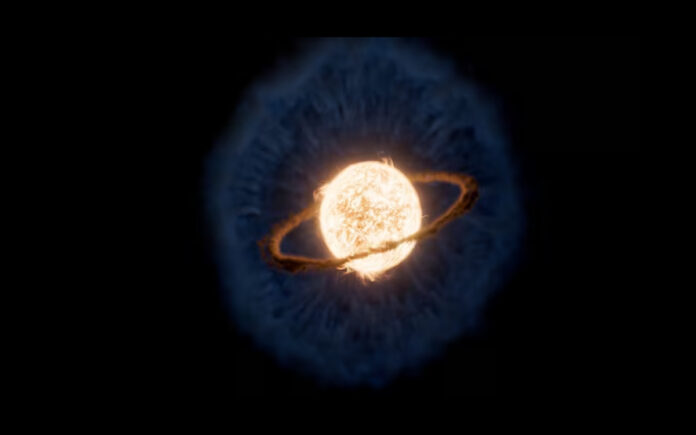Washington: Astronomers have unveiled new insights into a rare and dramatic cosmic event—the death of an alien planet as it plunged into its host star. Initially believed to have been engulfed when the star expanded into a red giant, new observations from NASA’s James Webb Space Telescope suggest a more complex and violent ending. Rather than the star expanding toward the planet, it appears the planet spiraled inward, ultimately disintegrating in a catastrophic collision.
The planet’s orbital decay, likely caused by intense gravitational interactions with its star, triggered its final descent—a spiraling “death plunge” that left behind a striking celestial aftermath. According to the study published in the Astrophysical Journal, Webb’s sensitive instruments detected swirling hot gas forming a luminous ring around the star and a cooler, expanding dust cloud—a cosmic shroud marking the event’s aftermath.
“We do know that there is a good amount of material from the star that gets expelled as the planet goes through its death plunge. The after-the-fact evidence is this dusty leftover material that was ejected from the host star,” explained Ryan Lau, lead author of the study and an astronomer at the U.S. National Science Foundation’s NOIRLab.
The doomed planet orbited a star approximately 12,000 light-years from Earth, located in the direction of the constellation Aquila within our Milky Way galaxy. The star is somewhat dimmer and redder than our sun, possessing about 70% of its mass. The planet is thought to have belonged to the class of “hot Jupiters”—massive gas giants orbiting very close to their host stars, which exposes them to extreme temperatures.
“We believe it probably had to be a giant planet, at least a few times the mass of Jupiter, to cause as dramatic of a disturbance to the star as what we are seeing,” said Morgan MacLeod, a postdoctoral fellow at the Harvard-Smithsonian Center for Astrophysics and co-author of the study.
The planet’s orbital path likely became unstable over time, leading it to gradually skim through the outer layers of the star before being completely devoured. As MacLeod described, “Then it starts grazing through the atmosphere of the star. At that point, the headwind of smashing through the stellar atmosphere takes over and the planet falls increasingly rapidly into the star.”
He further explained, “The planet both falls inward and gets stripped of its gaseous outer layers as it plows deeper into the star. Along the way, that smashing heats up and expels stellar gas, which gives rise to the light we see and the gas, dust and molecules that now surround the star.”
Also Read | Dominican Republic Releases Report on Nightclub Collapse That Killed 221
While the precise fate of the planet remains uncertain, astronomers continue to model the event using simulations to fill in the gaps. “In this case, we saw how the plunge of the planet affected the star, but we don’t truly know for certain what happened to the planet. In astronomy there are lots of things way too big and way too ‘out there’ to do experiments on. We can’t go to the lab and smash a star and planet together – that would be diabolical. But we can try to reconstruct what happened in computer models,” MacLeod added.
Although no planets in our solar system currently orbit close enough to suffer such a fate, the researchers caution that a similar end may eventually await Mercury, Venus, and even Earth. In approximately five billion years, the sun is expected to evolve into a red giant and may engulf its innermost planets during that phase, leaving behind a white dwarf core.
Also Read | Explosion Hits Hellenic Train Offices in Athens; No Injuries Reported
However, the Webb telescope’s findings suggest that a red giant phase might not be the only path to planetary demise. “Our observations hint that maybe planets are more likely to meet their final fates by slowly spiraling in towards their host star instead of the star turning into a red giant to swallow them up. Our solar system seems to be relatively stable though, so we only have to worry about the sun becoming a red giant and swallowing us up,” Lau concluded.
These groundbreaking observations mark a pivotal step in understanding the ultimate fate of planetary systems, revealing the destructive power of gravity and the fragile dance between planets and their stars.



